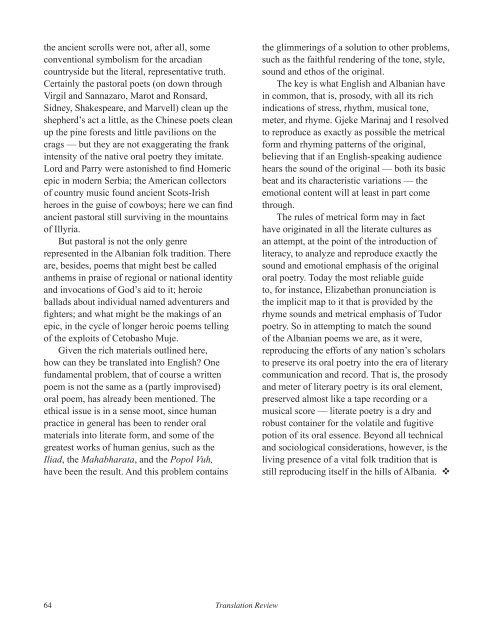Table of contents - The University of Texas at Dallas
Table of contents - The University of Texas at Dallas
Table of contents - The University of Texas at Dallas
You also want an ePaper? Increase the reach of your titles
YUMPU automatically turns print PDFs into web optimized ePapers that Google loves.
the ancient scrolls were not, after all, some<br />
conventional symbolism for the arcadian<br />
countryside but the literal, represent<strong>at</strong>ive truth.<br />
Certainly the pastoral poets (on down through<br />
Virgil and Sannazaro, Marot and Ronsard,<br />
Sidney, Shakespeare, and Marvell) clean up the<br />
shepherd’s act a little, as the Chinese poets clean<br />
up the pine forests and little pavilions on the<br />
crags — but they are not exagger<strong>at</strong>ing the frank<br />
intensity <strong>of</strong> the n<strong>at</strong>ive oral poetry they imit<strong>at</strong>e.<br />
Lord and Parry were astonished to find Homeric<br />
epic in modern Serbia; the American collectors<br />
<strong>of</strong> country music found ancient Scots-Irish<br />
heroes in the guise <strong>of</strong> cowboys; here we can find<br />
ancient pastoral still surviving in the mountains<br />
<strong>of</strong> Illyria.<br />
But pastoral is not the only genre<br />
represented in the Albanian folk tradition. <strong>The</strong>re<br />
are, besides, poems th<strong>at</strong> might best be called<br />
anthems in praise <strong>of</strong> regional or n<strong>at</strong>ional identity<br />
and invoc<strong>at</strong>ions <strong>of</strong> God’s aid to it; heroic<br />
ballads about individual named adventurers and<br />
fighters; and wh<strong>at</strong> might be the makings <strong>of</strong> an<br />
epic, in the cycle <strong>of</strong> longer heroic poems telling<br />
<strong>of</strong> the exploits <strong>of</strong> Cetobasho Muje.<br />
Given the rich m<strong>at</strong>erials outlined here,<br />
how can they be transl<strong>at</strong>ed into English One<br />
fundamental problem, th<strong>at</strong> <strong>of</strong> course a written<br />
poem is not the same as a (partly improvised)<br />
oral poem, has already been mentioned. <strong>The</strong><br />
ethical issue is in a sense moot, since human<br />
practice in general has been to render oral<br />
m<strong>at</strong>erials into liter<strong>at</strong>e form, and some <strong>of</strong> the<br />
gre<strong>at</strong>est works <strong>of</strong> human genius, such as the<br />
Iliad, the Mahabhar<strong>at</strong>a, and the Popol Vuh,<br />
have been the result. And this problem contains<br />
the glimmerings <strong>of</strong> a solution to other problems,<br />
such as the faithful rendering <strong>of</strong> the tone, style,<br />
sound and ethos <strong>of</strong> the original.<br />
<strong>The</strong> key is wh<strong>at</strong> English and Albanian have<br />
in common, th<strong>at</strong> is, prosody, with all its rich<br />
indic<strong>at</strong>ions <strong>of</strong> stress, rhythm, musical tone,<br />
meter, and rhyme. Gjeke Marinaj and I resolved<br />
to reproduce as exactly as possible the metrical<br />
form and rhyming p<strong>at</strong>terns <strong>of</strong> the original,<br />
believing th<strong>at</strong> if an English-speaking audience<br />
hears the sound <strong>of</strong> the original — both its basic<br />
be<strong>at</strong> and its characteristic vari<strong>at</strong>ions — the<br />
emotional content will <strong>at</strong> least in part come<br />
through.<br />
<strong>The</strong> rules <strong>of</strong> metrical form may in fact<br />
have origin<strong>at</strong>ed in all the liter<strong>at</strong>e cultures as<br />
an <strong>at</strong>tempt, <strong>at</strong> the point <strong>of</strong> the introduction <strong>of</strong><br />
literacy, to analyze and reproduce exactly the<br />
sound and emotional emphasis <strong>of</strong> the original<br />
oral poetry. Today the most reliable guide<br />
to, for instance, Elizabethan pronunci<strong>at</strong>ion is<br />
the implicit map to it th<strong>at</strong> is provided by the<br />
rhyme sounds and metrical emphasis <strong>of</strong> Tudor<br />
poetry. So in <strong>at</strong>tempting to m<strong>at</strong>ch the sound<br />
<strong>of</strong> the Albanian poems we are, as it were,<br />
reproducing the efforts <strong>of</strong> any n<strong>at</strong>ion’s scholars<br />
to preserve its oral poetry into the era <strong>of</strong> literary<br />
communic<strong>at</strong>ion and record. Th<strong>at</strong> is, the prosody<br />
and meter <strong>of</strong> literary poetry is its oral element,<br />
preserved almost like a tape recording or a<br />
musical score — liter<strong>at</strong>e poetry is a dry and<br />
robust container for the vol<strong>at</strong>ile and fugitive<br />
potion <strong>of</strong> its oral essence. Beyond all technical<br />
and sociological consider<strong>at</strong>ions, however, is the<br />
living presence <strong>of</strong> a vital folk tradition th<strong>at</strong> is<br />
still reproducing itself in the hills <strong>of</strong> Albania. v<br />
64 Transl<strong>at</strong>ion Review

















